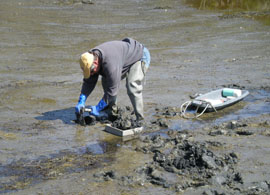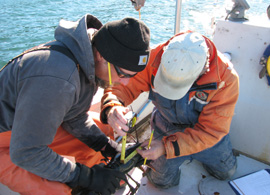

Sampling a plot during a soft-shell
clam survey

Measuring an over-sized lobster in
eastern Maine
Services:
Resource assessments
MER conducts soft-shell clam, Mya arenaria, surveys to develop standing crop estimates to assist coastal municipalities in establishing appropriate shellfish harvesting license levels where limited entry is used as a resource conservation measure. Surveys are conducted according to a standard method developed by the Maine DMR. Appropriate license levels are calculated using a “following-year” model developed by Chris Heinig that predicts standing harvestable crop based on clam length-frequency distribution at time of survey, incremental growth, natural and fishery-related mortality, harvest efficiency, and harvest yield and effort per harvester. These survey techniques and other aspects of the clam industry in Casco Bay are discussed in Economic Analysis of the soft-shell clam, Mya arenaria, industry in Casco Bay, (Heinig et al., 1995).
Lobster resource assessments are conducted using a combination of fishery-independent and fishery-dependent methods. Fishery-independent methods are used to develop density estimates and rely primarily on quantitative diver observations, usually documented with video recordings, combined with rate of burrow/depression occupancy estimates. Fishery-dependent methods yield catch data from trapping using standard commercial traps, modified vent-less traps, or a combination of the two. Trapping efforts also allow collection of morphometric data such as overall length, carapace length (CL), sex, egg development stage if present, general condition, and presence or absence of shell disease, among others.
Copyright, 2009 MER Assessment Corporation 14 Industrial Parkway, Brunswick, Maine 04011
207.798.7935 (V) / 207.729.4706 (F) / 207-751-3696 (C)